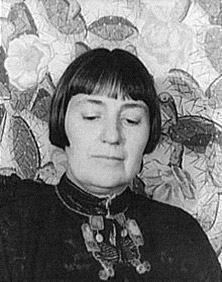Mabel Dodge Luhan (1879–1962)
 Mabel Dodge, 1934. Courtesy of the Croton Historical Society.
Mabel Dodge, 1934. Courtesy of the Croton Historical Society.
Mabel Dodge Luhan was an American writer, hostess and inspiration to a vast array of artist, writers and political reformers. She was born in Buffalo, New York in 1879. Her parents, Charles and Sara (Cook) Ganson were independently wealthy members of society who virtually ignored Mabel as a child.
Mabel was educated in finishing schools in New York and Maryland and was presented to society in 1898 at a cotillion in Buffalo. Her first of four marriages was to Karl Evans, the youngest son of a steamship owner. Just after the birth of their son John, Karl was killed in a hunting accident.
Her family sent her to Europe to recover. Her European trip was the first of three important journeys in her life which marked her search for personal identity—the second would be to Greenwich Village in New York City and the third to Taos, New Mexico. On her ocean voyage to France she met Edwin Dodge, a wealthy Boston architect. After a short courtship they were married in 1905 and moved to Villa Curonia, a large estate outside of Florence, Italy. The couple spent the next eight years collecting art and creating their own Renaissance paradise. It was during this period that Mabel became famous for her lavish parties where she entertained the cream of international society.
By 1912 Mabel had become bored with her life in Italy, and returned to The United States settling in Greenwich Village. She had separated from her husband and moved to an apartment at 23 Fifth Avenue. There she launched the most successful salon in American history. For the next three years she entertained writers, artists, philosophers, reformers and radicals of all kinds. Her Wednesday guests included Margaret Sanger, Lincoln Steffens, Emma Goldman, Walter Lippman, Max Eastman, and John Reed.
She gave generously of her time and fortune to support causes that she felt would liberate the country from its Victorian past. She helped sponsor the Armory Show which introduced post-impressionist art to the American audience, wrote a syndicated column for the Hearst newspaper chain, contributed writing to THE MASSES, and joined the campaigns for women’s suffrage, birth control rights, and international peace.
In June of 1913 Mabel sailed to Europe with journalist John Reed. They became lovers and entertained Pablo Picasso, and Gertrude Stein in Paris before traveling on to the Villa Curonia in Italy. They spent the summer there entertaining Arthur Rubinstein and other important guests. They returned New York in September of 1913 when Jack was called to report on the Mexican Revolution for THE MASSES.
Mabel rented a cottage on Mt Airy Road in Croton to be near her friend Elizabeth Duncan (sister of dance pioneer Isadora Duncan) who was establishing a dance school there. Her affair with John Reed had come to an end. She found Croton to be a peaceful place to leave all of the pressing political and social issues of the day behind. In 1916 she bought an estate on Finney Farm. She moved there with Maurice Sterne, an artist, who soon became her third husband.
In 1919 Mabel left Croton and moved with Maurice to Taos, New Mexico. She bought a twelve acre property and started a literary colony there. For the rest of her life she took the lead in calling “great souls” to Taos to help create “a city upon the hill.” Among the “great souls” who visited her Taos home were D.H. Lawrence, Willa Cather, Edna Ferber, Georgia O’Keefe, Leopold Stowkowski, Thomas Wolfe and Mary Austin.
In 1923 she divorced Sterne and married a full-blooded Pueblo Indian, Tony Luhan. She published four volumes of memoirs: Background, European Experiences, Movers and Shakers, and Edge of Taos Desert.
She died of a heart attack in 1962 and is buried in the Kit Carson Cemetery there.